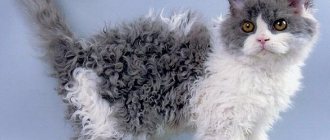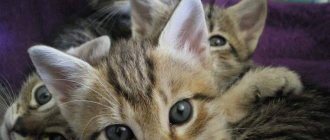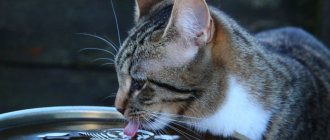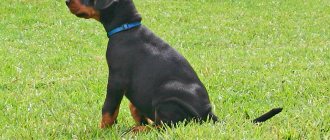7056Administration
Domestic cats are not only pets of familiar breeds. A manul cat at home is very exotic. There are people who are ready to make their furry friend a unique animal that is on the verge of extinction and, in order not to disappear from the face of the Earth, needs serious help from humans.
We are talking about a steppe cat, which is called manul or pallas. Its Latin name is felis manul, and its synonym is otocolobus (translated as “ugly ear,” although its rounded ears are not at all ugly). The description of the appearance of a powerful pallas with very thick and long fur, the size of a large domestic cat, is very attractive, but the best idea of this impressive animal is given by a photo. The wild cat Pallas is not often kept at home, but it can still become a four-legged pet. However, when deciding to get such a pet, it is necessary to take into account many of its features, since the Pallas's cat, even raised in captivity, cannot fully adapt to being kept at home and always remains a wild animal at heart.
© shutterstock
Features of the Pallas's cat
A manul living in a person's house does not become an ordinary pet . Unlike some wild cats, such as caracals and servals, which are completely domesticated, the Pallas's cat always remains wild, even if it begins to trust its owner. Because of this, if the cat decides that he is in danger, he will defend himself against the person who raised him, causing serious damage to him with teeth and claws that are much longer and stronger than those that domestic cats have.
It is generally accepted that a wild animal, if taken into a home as a child, gets used to its owner and after a certain time becomes completely tame. This statement does not apply to Pallas's cat. It is impossible to predict what kind of domestic cat the manul will grow up to be. Even if a wild kitten was given to be raised by a domestic cat, which raises it along with its kittens, you cannot be sure that, having matured, the Pallas's cat will not seek solitude, hiding from humans and the other cats with whom it grew up.
At the same time, there are also individuals who, growing up in a house, become devoted to their owner and maintain a close connection with them throughout their lives. Such cases are rare, and therefore, when deciding to have a Pallas's cat in your home, you should not rely on such exceptions in the domestication of a wild cat.
When deciding to keep a Pallas's cat, you need to take into account that, most likely, the animal will remain wild, although not aggressive. The Pallas' cat's behavior towards others at home will retain a character similar to its habits in the wild. The pet will try with all its might to minimize contact with humans, hiding in secluded places.
It is also important to remember that a cat needs a large area for walking. Due to the fact that the Pallas cat can easily leave the house and is not attached to it, for walks it is optimal to arrange and equip a cat enclosure, which will contain :
- house,
- lounge chairs,
- climbing structures,
- drinking bowl,
- feeder
If desired, it is possible to keep the Pallas's cat in an enclosure all year round. Animals tolerate low temperatures well when there is good shelter. To do this, you will need to properly insulate the cat’s house so that even in severe frost the animal feels comfortable.
Tamed manul
It is not for nothing that the Pallas cat is considered an exotic animal. It will not be possible to completely tame him. Therefore, even if you bought him as a small child, you should not count on him becoming a tame kitten. The instinctive isolation of the Pallas's cat from humans will be inherent in it even when kept at home.
And even if at a young age a kitten is still able to play with human hands, then after puberty this will no longer be possible, instincts will take over.
Increasingly, exotic animals are chosen as pets: lemurs, raccoons, salamanders, crocodiles, leopard geckos, snails, iguanas, chameleons, squirrels, jerboas.
Conditions for keeping
Of course, the best place to keep such a pet would be a private yard. The cat can withstand low temperatures, and the open space, trees and bushes will remind him of his natural habitat. In addition, in the yard it will be more comfortable for him to lead a nocturnal lifestyle and not disturb the owners.
It is absolutely not suitable for keeping in an apartment, since it is unlikely that it will be possible to provide him with conditions where he can hide and where he will not cause inconvenience by going out to hunt at night. In addition, you must always remember that entering its territory is taboo for a person; he risks getting bitten and scratched.
Important! Despite its slowness, the wild cat has lightning-fast reactions and can attack an enemy without warning. His dissatisfaction will not be revealed by any external manifestations, because his muzzle always has an angry and wary expression.
.
Breed care
Like any wild animal, the manul is capable of caring for itself. It is unlikely that you will be able to accustom him to forced water procedures. The only thing you can try in terms of grooming is combing out the animal’s fur, which is almost constantly in a state of shedding. Owners of Pallas cats in their apartments feel this well, finding clumps of cat hair throughout their home every day.
What to feed a wild cat
What to feed the animal is one of the first questions that a person who is planning to get a Pallas's cat should ask himself.
In the wild, this feline feeds on the Daurian pika and small rodents. As a rule, it watches for them, hiding near their holes. It can also hunt hares, marmots, and birds. If food is tight, it eats insects.
Whether you can provide your pet with such food is up to you to decide. After all, there are big doubts that a wild animal will want to eat dry cat food or canned food. At the zoo they are fed meat and rodents.
Did you know? Manul was first discovered in the 18th century by naturalist Peter Simon on the shores of the Caspian Sea. It was named Otocolobus, meaning "ugly ear".
Difficulties of home maintenance
Keeping wild cats as pets is not easy and is not always justified. Having decided to have a Pallas's cat at home, you need to be prepared for a number of difficulties that will arise in such a neighborhood. This wild cat is self-sufficient, and therefore it does not need people or other animals at all, with the exception of rodents, which the Pallas's cat loves to hunt. Manul is not the affectionate domestic cat that everyone is used to; and he will not sit on his lap, enjoying communication with his master. Keeping Pallas cats at home is associated with serious problems .
- Aggressive behavior towards children if they become overly persistent in pestering the animal, imposing their communication on it and especially trying to remove it from the chosen den. These are not your typical domestic cats.
- Damage to everything around. Pallas' cats are similar to teenage puppies, who tend to damage furniture and shoes by chewing them. The cat will happily try many things, and will also constantly scratch furniture, walls, curtains and even linoleum. Due to the special strength of the teeth and paws, the damage caused by a Pallas's cat living at home is very significant. Having settled an animal, you need to remove expensive things from its access area. Pallas' cats are not domestic cats that respect their owner.
- Treatment problems. Due to the behavior of a wild cat, if it has health problems, you may not immediately pay attention to them. Also, due to the fact that the animal is wary of people, it will be quite difficult for a veterinarian to examine it properly. An additional problem will be the fact that there are few specialists who know the characteristics of these animals. Therefore, treatment for Pallas cats will most likely be carried out in a similar way to what domestic cats receive, but this is not true.
- Constant shedding. The manul has particularly thick hair up to 7 cm long. The cat sheds very rapidly in the autumn and spring. During the rest of the year, the Pallas' cat's fur is actively replaced, and therefore shreds of it will always be present in the apartment. In order to reduce the contamination of your apartment with fur, you need to regularly brush your exotic pet, which is extremely difficult if it is too wild. Domestic cats shed 2 times a year.
- Hunting instinct. The cat is strong and perfectly adapted for hunting not only small rodents, but also marmots, which is why it can pose a danger to small pets, including puppies and small breed dogs, which the pet may decide to feast on as if it were fresh game. .
Content issues
There are only a few known cases when Manul behaved adequately at home. Usually a wild animal does not accept its owner, so it secludes itself or causes a pogrom.
The complexity of the content lies not only in its behavior, but also in its physiological characteristics. The cat sheds a lot because an apartment is not his habitat. Eating problems may also arise. In the wild, the predator feeds on rodents and small mammals, obtaining a sufficient amount of useful substances naturally. In order for the patient to feel comfortable, it is necessary to create a balanced diet for him.
As for the continuation of offspring, it will be almost impossible to find a mate for such a rare pet, and they cannot be castrated or sterilized. In the spring, Manul will “demand” mating, and it is unknown how hormonal disruption will affect his behavior.
Most veterinarians will not be able to treat an exotic pet in case of illness due to insufficient qualifications.
Appearance of the Pallas's cat
The Pallas's cat is very similar in size to an ordinary domestic cat, and although it seems much larger than a cat, this is only because of its thick and long (up to seven centimeters) fur. The standard size of the body length of the Pallas's cat is within 65 cm, and the weight can reach only 5 kg. The coat color of this predator is light gray interspersed with white or yellowish color. Looking at it, it seems that it is covered with snow, and this is an ideal camouflage in the wild. The manul also differs from the domestic cat in its wide
flat head, as well as small, widely spaced ears. The pupils, unlike the pupils of a domestic cat, even in bright light do not take on a slit-like appearance, but remain constantly round. The lifespan of Pallas's cat in captivity is 11 or 12 years, but in the wild it is unknown how many years they live. Pallas' cats are found in the wild in Transcaucasia, Asia, Mongolia and China. This species of cat is on the verge of extinction, but since they have a very secretive nature, it is not possible to calculate the exact number of Pallas' cats in nature.
Pallas' cats are unpretentious, so they easily adapt to life in the zoo, however, as for reproduction, it is worse in captivity than in the wild. And those kittens that are born within the walls of the zoo do not have very good immunity and are susceptible to various infections that are fatal to them.
Interesting Facts
Instead of such a pet, it is better for a person to get a British one, which has a soft and flexible character.
Japanese scientists tried to cross a Pallas cat with a domestic cat, and they managed to get a hybrid. But the animal still inherited a tough, nasty, quarrelsome character. In the natural environment, there are also cases when a male Pallas cat covers an ordinary cat. Owners of such animals note that the offspring have a predominant appearance, character and habits of wild cats. Therefore, if you want to have a feline pet at home, it is better to take a closer look at other breeds that are more delicate, kind, easy-going, and loyal. These varieties include:
- Maine Coon;
- British and Scottish;
- Siberian;
- Burmese;
- Kurilian bobtail.
Wild cat lifestyle
The Pallas's cat's habitat is in areas where low temperatures and a generally harsh climate, without much snow, prevail. He chooses mountainous semi-desert areas for housing, and may even be in mountains reaching a height of 4 km. The abundance of shrubs also applies to the preferences of the Pallas's cat. It almost never changes its favorite places; it settles in an abandoned badger or fox hole. Leads a twilight and nocturnal lifestyle, hunting strictly at this time. Pallas's cat cannot be called fast and dexterous; on the contrary, he is clumsy and slow. When he hides from enemies or hunts prey, he hides on a rock and waits. It is almost impossible to notice it, since thanks to its color it merges with the mountain nature.
The hunting of the Pallas's cat consists in the fact that it guards its prey at its hole, and when it hides and sits in ambush among the stones, it patiently waits for the appearance of a rodent. It happens that he comes across a baby marmot, a gopher, and also a hare. When problems with food arise and it becomes scarce, the manul begins to eat insects.
Lifestyle, natural habitats
The species is included in the third category of protection, as rare on the periphery of its range, and is included in the Red Books of Russia, China, Kyrgyzstan, Kazakhstan, and Mongolia. This is one of the least studied representatives of felines, whose habitat occupies an area from Transcaucasia to eastern Mongolia. Pallas' cats live in Armenia, Azerbaijan, China, Russia, India, Iran, Kazakhstan, Kyrgyzstan, Mongolia, Pakistan, Turkmenistan, and Uzbekistan.
Scientists do not name the exact number of manuls, since it is impossible to carry out calculations . Cats lead a solitary lifestyle, prefer to hide away from human eyes, and they do not have the best relationships with their fellow cats. At the same time, there is scientific evidence that although their habitat has not changed over the past few decades, the population size is declining every year. It is known that Pallas' cats have disappeared from the Caspian region and Eastern China.
At the turn of the 1990-2000s. the total number of Pallas' cats in Russia was estimated at 3000-3650 individuals.
Reference. The species is endangered and is included in the Potential Threat subcategory of the Reduced Risk category of the IUCN Red List, as well as in Appendix II of the CITES Convention.
Over the past 15 years, cats living in open steppes have been almost completely exterminated , and their habitat is becoming limited. Pallas' cats prefer to settle in treeless mountainous areas, arid regions, rocky deserts and steppes of Asia and southern Siberia.
The northern border of the range is located on the territory of Russia, which borders Kazakhstan, Mongolia and China. Cats live in Altai, Tuva, Buryatia and the Chita region in steppe and semi-desert areas with herbaceous and shrub vegetation located fragmentarily, in areas with finely dissected relief, rocky areas, low mountains with outcrops.
The most comfortable living conditions are rocky outcrops and large areas of bushes . Here cats make their abode and hide during the day. The climate in the area is sharply continental, the air temperature in winter is -50 °C. Pallas' cats do not settle where the snow depth exceeds 20 cm, since their short legs are poorly adapted to move through such terrain.
Pallas' cats lead a sedentary lifestyle . The peak of activity occurs mainly at dusk and early morning. During the day, cats sleep in a den, which they make in rock crevices, under stones, caves, and in abandoned burrows of foxes, marmots, and badgers.
Reference. The color of the Pallas's coat is determined by its habitat and helps it hide among stones and thickets when hunting.
By themselves, these wild cats are slow and clumsy . They are not adapted to fast running and often become prey to large dogs, predators and humans. Cats often turn towards their pursuer, stop, sit on the ground or lie on their backs.
The characteristic behavior in case of danger is hiding, which can be fatal for the animal. To escape from enemies, cats climb onto rocks and stones. Alarmed animals begin to purr hoarsely or snort sharply.
How the Sphynx cat breed was developed
Description of the Havana Brown cat breed
Burmilla breed
Is it possible to keep him at home?
Unlike its relatives, the Pallas's cat cannot be domesticated due to its indomitable nature. It is believed that if any animal is taken home when it is still a small kitten, it can grow up tame, with behavior no different from a domestic cat. But this is not about the manula. There are no guarantees that it will take root. Even if he is raised by a domestic cat along with his kittens, the manul will not be able to love them, and when he grows up, he will be aloof both from his half-sisters and brothers, and from people whom he has known since childhood. You need to know about this in advance before the manul appears within the walls of the house in order to make a decision for yourself whether such a wayward pet will suit you.
External characteristics
Despite the similarities with the Persian and Angora breeds, the animal has distinctive features:
- ears are located almost at eye level;
- disproportionately short legs;
- fangs are 3 times longer than those of domestic cats;
- always a gloomy expression on the face;
- black transverse stripes on the body and cheeks;
- eyes are set wider apart than other cats;
- does not know how to meow, makes sounds similar to rumbling when he is dissatisfied or scared.
A striking difference from its domestic relatives: the Pallass cat’s pupils do not shrink from light
Manul at home
In the zoo, as mentioned above, the Pallas's cat can easily live and even reproduce. This is due to the fact that there it is much easier to create conditions for him as close as possible to his habitat in the wild. The Pallas's cat has become so alienated precisely because it lives in areas with very small populations. And in a zoo, being in his enclosure, he will feel at home. Today you can find one and a half hundred Pallas' cat cats in 50 zoos around the world.
But with Pallas's cats within the walls of a house or apartment, everything is much more complicated. As you know, some breeds of domestic cats can constantly hide somewhere and protect their shelter from people trying to get into it. Manul will behave the same way - he will
to staunchly defend the place allocated for him for housing. Although by nature it is not an aggressive predator, in this case it is quite capable of attacking a person. And his teeth and claws are sharper than those of any domestic cat.
If the Pallas's cat gets sick, then, since he does not allow anyone near him due to his unsociability, it will be problematic to examine him in order to diagnose the disease and treat him. Pallas' cat breeding in apartment conditions, unlike keeping in zoos, will also face great difficulties.
Features of home maintenance
The Pallas cat breed has an angry, indomitable, aloof character. Therefore, keeping this animal in the house is not recommended. The second name of the breed is Pallas's cat, he received it in honor of the scientist P.S. Pallas, who described the Pallas cat for the first time.
The animal has a tough temperament, so petting it is not always safe.
A cat will never become tame, even if the baby has lived with a person since childhood, this will not guarantee that it will become tamed. The mature predator avoids the domestic cat family and does not get along with animals of other species. It seems that a cat always looks unhappy, so not every person will dare to pick it up or even stroke it.
Care and maintenance
An urban habitat is absolutely not suitable for Pallas' cats; the animal will never live in an apartment. If the final decision is made to purchase this type of cat, it is necessary to provide it with a spacious territory, it is better that it is a large private yard where trees, bushes grow, and there are stones.
Manul rarely allows himself to be touched, so it is impossible to care for him like a domestic cat. The animal will not tolerate water procedures, but you can accustom it to combing. Removing excess hair is useful because cats are always shedding. The owners of those Pallas cats that are kept in the house note that the animal leaves shreds of wool all year round.
Feeding
Living in freedom, such animals eat small rodents.
In the wild, Pallas' cats feed on small rodents, mammals, birds, and insects. Even a tamed predatory cat will not eat dry food or factory canned food. This information should be taken into account by future owners, because if the animal does not receive the necessary feed, it will not be able to live in the house. Kittens that were born in the zoo are fed raw meat and rodents.
Diseases and health
Pallas' cats have strong, heroic health. The animal's body is adapted to a harsh survival environment, so cats rarely get sick. Most often, predators suffer from viral pathologies, toxoplasmosis; other ailments are rare. But even when the cat feels bad, he will not even let the owner near him, not to mention the veterinarian. The animal will show aggression, hiss and scratch, so even with a strong desire to help the pet it will not be possible.
Reproduction
Already at the age of 10 months. the female is ready to mate and bear offspring. Pregnancy often proceeds without complications. After 60 days after mating, blind babies are born, the maximum number of them in 1 litter is 6. The cats develop quickly, and already at the age of 4 months they become able to get their own food. In the wild, not all cubs can survive, because while their immunity is developing, they often suffer from viral diseases.
Problems created by manul at home
The Pallas's cat is such an unsociable representative of felines that it would hardly have noticed the disappearance of animals and humans from the face of the earth. That is why people who decide to place this predator in their home should think carefully. Some, despite possible difficulties or due to a simple misunderstanding, still decide to get a Pallas's cat. In this case, they risk encountering the following problems:
- As mentioned above, this wild animal will constantly hide from its owner and avoid him, so it is unlikely that he will be able to enjoy communication with him.
- Dog owners are well aware of their behavior in terms of the fact that dogs at a young age spoil everything in the apartment. The same thing will happen with a Pallas's cat that finds itself in a home environment - it will damage wallpaper, furniture, curtains and other items.
- A sick Pallas's cat cannot be cured at home, and in veterinary clinics not every specialist knows this animal and the diseases to which it is susceptible so well, so there is a high risk that the Pallas's cat will be treated like an ordinary domestic cat.
- The long seven-centimeter fur of the Pallas's cat can become another problem. He sheds heavily and almost always. Shreds of wool will fly throughout the apartment. And in order to reduce their number, the manula will need to be combed.
Knowing about all the difficulties of keeping a manula at home, you should not rely only on your desire. There are cases when people, succumbing to an impulse, settled these predators in their homes, but very quickly realized that they could not tame it after all, and brought it to the zoo. But we can say with confidence that keeping a Pallas's cat at home is not recommended for two reasons: firstly, it can cause damage not only to a person's home, but also to himself, and secondly, the Pallas's cat is already on the verge of extinction, that's why keeping him in captivity is considered a very irresponsible act.
The Pallas cat has a charismatic, brutal appearance: small size, small ears, huge green eyes, long fur, strong body structure, luxurious tail.
This makes him a desirable pet among lovers of exotic pets. Is it worth keeping a wild cat at home and is it even possible?
Reviews from Manul owners
What stories do people tell about keeping Pallas's cat at home?
Igor, Sakhalin
“The little Manul ended up in our house quite by accident, but that’s not what the story is about, so I’ll tell you right away the details of keeping such a rare pet. My family and I did not notice anything aggressive in his behavior. We have a large yard, so the cat spends most of his time outside; he only comes home to sleep and sometimes eat. He doesn’t allow himself to be petted, but he doesn’t run away either; he can scratch or snort. He doesn’t like the dog, so we keep him in an enclosure all the time. In general, you can get along with a Pallas’s cat, but you shouldn’t buy a kitten on purpose.”
Elena, Yakutsk
“We bought Manul out of stupidity. Before puberty (10 months), the kitten was playful, kind and tame, but after that there were incredible changes in behavior. The cat began to attack us and bite us hard. It turned out that this is possible due to hormonal changes. I had to give my pet to the zoo.”
Kirill, Ulan-Ude
“The Pallas cat is an incredibly beautiful, but wild animal, so keeping it at home is not recommended. Once in the steppe we saved an 8-month-old kitten from poachers. We took him home for a while and then gave him to the zoo. The little cat stayed with us for only a few months, but during this time we managed to feel his aggressive character. The domestic cats were scratched, the dog did not enter the house, and the children avoided the rescued cat. We safely handed the baby over to the experts and were happy. We definitely do not recommend domesticating this wild feline.”
Remember that keeping endangered wild animals at home is a serious threat to their lives and nature as a whole.
Domestic manul: is it possible to keep it in an apartment?
The Pallas' cat looks as if he skipped about 12 million years of evolution and somehow, incredibly, got from the era of dinosaurs, saber-toothed tigers and pterodactyls into the modern world. Natural habitat - India, Pakistan, Siberia, steppes of Mongolia.
It feeds on rodents, birds, lizards, insects, baby hares and other small animals. Otocolobus manul or Palass's cat, belonging to the cat family, is on the verge of extinction. Having such a pet at home is an attractive idea.
In practice, an animal, even adopted by a small kitten, will never become completely domestic and tame. It is possible to keep it in an apartment or a private house, understanding the characteristics of the species, accepting difficulties, and not expecting unusual behavior from the animal.
Characteristics and description of the appearance of the Pallas's cat
Manul is a predatory representative of the cat family . The second name, Pallas's cat, was given in honor of P. S. Pallas, a German naturalist who was the first to describe the cat in 1776.
The cat is attractive with its lush fur, fatness and stern look . The appearance of the cat is deceptive; many people think that it is a large animal, but in fact the body length of males does not exceed 62 cm, on average - 50-55 cm. Tail length - 23-31 cm, weight - 2.5-4 kg. Females are slightly lighter than males, body length is approximately the same - 49-53 cm, maximum 60 cm.
The cat's head is round and medium in size . The ears are set wide. A distinct pattern is visible on the muzzle, the front part is flat.
The color of the iris is yellow . A characteristic feature of Pallas' cats is that their pupils do not narrow in bright light, but remain round.
The cheeks are covered with tufts of long hair.
The limbs are short , the tail is thick, covered with gray hair, the tip is black.
The coat is thick and fluffy . On one square cm of the back grows about 9 thousand hairs 7 cm long. The color of the coat is light gray and fawn-ochre, hairs with white tips. It seems as if the cat's fur coat is dusted with snow. On the tail and back of the body there are narrow transverse stripes of dark gray color; vertical black stripes are visible from the corners of the eyes on the sides of the muzzle. The fur on the belly is brown with a white coating.
Scientists agree that Pallas cats are close relatives of Persian cats . This conclusion is based on the appearance of the animal. Persians have a similar coat structure, head shape, and rounded shape, which distinguishes them from other breeds.
Wild cats vary in color and size depending on the subspecies and habitat :
- Otocolobus manul manul are typically colored animals that live throughout most of their range, often found in western China and Mongolia.
- Otocolobus manul ferruginea - animals with a red-ocher color, with clear red stripes, living in Iran, Turkmenistan, Uzbekistan, Kyrgyzstan, Afghanistan, Kazakhstan, Tajikistan, Pakistan.
- Otocolobus manul nigripecta are greyish-colored animals that turn silvery-gray in winter, living in Kashmir, Tibet and Nepal.
On average, cats live 11-12 years . Individuals who end up in zoos have a high chance of living a long life. For example, in the Moscow Zoo one cat lived to be 18 years old.
Reference. The Pallas's cat was the symbol of the capital's zoo in 1987-2014.
The first wild cats appeared in the country's main zoo in the 50s. XX century , and since 1975, zoo workers began breeding them regularly.
Some zoos in Europe and the USA purchased kittens. Despite the difficulties of breeding and keeping in captivity, the Moscow Zoo has become the leader in the number of Pallas' cat births.
Manul at home
The Manul will never behave like an ordinary domestic cat. He will avoid contact with people and other pets in every possible way. Hunting season will be announced for small animals and poultry. Small breed dogs, kittens, and puppies fall into the category of potential game. His freedom-loving nature does not need the company of strangers or relatives.
Planning to breed steppe cats at home is a disastrous idea. The male and female will be in a state of constant competition for the best secluded places and territories. Offspring will be at the very bottom of the couple's list of interests.
Even in zoos, where Pallas cats are provided with favorable conditions for breeding, it is rarely possible to wait for offspring. If a miracle happens, kittens often die, and adults also become victims of infections. What can we say about home maintenance? Pallas cats are under state protection as a species listed in the Red Book. It is not possible to legally purchase a kitten.
Is it possible to tame a manula?
There are cases when Pallas' cat babies were fed by a domestic cat, but as they grew up, the adoptees did not adopt her behavior, remaining independent and aloof.
Domestication is a matter of luck, not technology. Rarely, there are individuals that are loyal to people and do not try to hide when the owner approaches. In any case, playing with him, stroking a pet lying on your lap is not about the Pallas's cat.
Manul at home: pros and cons
One of the advantages is that the animal does not require the owner’s attention, and the latter’s ego will be stroked by the rare pet. Otherwise, exotic will bring more problems than pleasure. It is strictly not recommended to have it in an apartment where children live. The predator will not tolerate intrusiveness, familiar treatment, attempts at advances, and the child will receive injuries from its claws and teeth.
Characteristics and behavior complicate treatment if the animal gets sick. Because of the Pallas' love for solitude, it is difficult for the owner to notice in time that the ward is behaving strangely, experiencing pain, and discomfort. Transportation to the clinic and a full examination by a veterinarian will turn into a quest.
It will be difficult to find a doctor who is familiar with the peculiarities of somatic diseases and infections in Pallas cats, who understands how and how to treat them. Most likely, the doctor uses techniques suitable for domestic cats, and this will lead to complications and the potential death of the wild animal.
Possible difficulties and illnesses
In the process of keeping Pallas's cat in captivity, problems may arise with treating the animal, since very few veterinarians are familiar with the characteristics and diseases of the species, and methods for domestic cats are not always applicable to it. In addition, the mustachioed-striped one simply will not let anyone near him, even at moments when he is unwell.
Of the most dangerous infections that are typical for this furry animal, the most likely is toxoplasmosis.
Manul at home: possible problems
Domestic cats shed seasonally: in spring and autumn. During these periods, the Pallas's cat also renews its coat. The rest of the time, his long (up to 7 cm) coat and thick undercoat come out in clumps. To avoid “hair growth” on the furniture, carpets will have to comb the pet daily, who will avoid the procedure in every possible way and offer active resistance.
The manul is similar in behavior to a grown-up puppy; he actively chews everything he finds attractive, gnawing shoes, table legs, sofas to splinters and small pieces.
Do not mind sharpening its claws on upholstered furniture, walls, laminate flooring, doors, leaving deep furrows. The strength of the manula's jaws and paws is superior to its domesticated relatives, and the damage will be much greater. It is useless to punish and educate a palassa cat.
Breed Features
Outwardly, the manul is almost indistinguishable from a domestic cat. A medium-sized cat weighs about 4 kg. The illusion of the large size of the animal is created due to the abundant growth of fur.
For comparison: the popular Maine Coon is at least 2 times larger than the Pallas cat; The wool density of Merino sheep is 8800 hairs per 1 square meter. cm, for Pallas's cat this figure is 9000.
Maine Coon appearance
The animal's body is dense and muscular, its legs are short, and its tail is voluminous. The seemingly discolored tips of the hairs serve as camouflage during winter hunting.
The flat face and rounded shape of the ears suggest that Pallas cats are related to Persian cats. The animal's eyes are designed to prevent drying out: nictitating membranes ensure frequent blinking.
Kinds
At the moment, scientists identify several varieties of Pallas's cat - all their differences largely come down to one or another coat color.
Table 1. Types of Pallas's cats
| Name | Color |
Siberian | Light gray |
Central Asian | From dark gray (summer) to silver (winter) |
Tibetan | Red, with pronounced red stripes |
Video - Manul: all about the unusual breed of cats
Nuances of keeping a manul
The only possible option for keeping a wild cat at home is in an enclosure. There he will feel relatively comfortable, a hole where he can retire and a piece of personal space for walking and lying in the sun. It is good to equip the enclosure with thick driftwood, on which the animal can climb and sharpen its claws on them.
Pallas' cats are fed fresh, pre-frozen meat, and given milk, kefir, and eggs. Sometimes chopped offal can be mixed with steamed buckwheat, rice, and vegetables. Traditional commercial cat food is not suitable for them.
Description of Pallas's cat
The size of the Pallas' cat is not much larger than that of a domestic cat: it weighs up to 5 kilograms and its body length is about 65 centimeters. It looks larger thanks to its very fluffy, dense fur - this feature makes scientists think about the possible relationship between the Pallas's cat and the Persian cat. This breed of wild Pallas' cat has a specific, flat head shape and smooth body shape in common. The color of these animals is usually light gray, sometimes with white or yellowish patches. Pallas' cats live in the wild in Asia, Transcaucasia, China and Mongolia. The number of these animals is constantly declining, and the species itself is on the verge of extinction. But it is not known exactly how many Pallas' cat lives in the wild: it has a secretive nature and a variety of habitats.
The Pallas cat adapts well to life in the zoo; it is easy to keep in captivity, since it does not require heat or large cages. But it reproduces worse in such conditions, and many kittens die from infectious diseases.
Why can't you tame the Pallas's cat?
It took humanity millions of years to domesticate the wild ancestors of the modern cat; gradually, naturally, the most sociable, good-natured individuals remained near people. Manul is a child of the wild, living in freedom. Like any free animal, natural conditions are close to him, where he is the master of the territory, hunting, swimming according to his own rules, without needing the patronage or tutelage of the owner.
Keeping a Pallas's cat at home is a wrong decision. For a wild cat, life in captivity will be dreary and joyless. They cannot be castrated or sterilized; the operation will lead to hormonal imbalances.
A person will receive as a pet an untamed animal that avoids contact with the owner, household members, and is capable of injuring children and other pets. There are a sufficient number of cat breeds, including rare, expensive ones, ready to become companions and loyal friends of the family, a source of pride and prestige.
Features of reproduction
Sexual maturity in a wild cat occurs at the age of 10 months. Mating occurs from February to March. Females give birth once a year. The duration of pregnancy is 60 days. Typically, two to five kittens are born. Like their domestic relatives, they are born blind. Vision is gained only after 10-15 days. And already at three or four months of age they go hunting for the first time.
It should be noted that not all kittens survive. Babies are too susceptible to infectious diseases. In captivity, cave cats rarely breed. In addition, finding a mate will be a big problem for him.
Lifestyle
Wild cats lead a solitary, sedentary lifestyle. They prefer to settle in rocky areas (hence another name - cave cat). Pallas' cats make dens in stone crevices; with their sharp claws they can dig a hole for their own housing. The animals carefully guard their home and drive away any stranger who looks there.
The love for rocky terrain and cold winters with little snow determine the range of animals: Tibet, Western China, Transbaikalia, Mongolia, Afghanistan.
Pallas' cats prefer a nocturnal lifestyle: they hunt only in the dark.
Pallas cats are considered the first cats to appear in the world.
The prey of wild cats are mice, small hares, small birds, and marmots. Nature has not blessed cats with quickness, so they can wait for hours for future food near their holes. In summer, insects and plants are added to the diet. All because of the same slowness, manulas themselves become the subject of hunting by larger predators. These felines cannot escape; when in danger, they hide or climb a tree.
In mating games, Pallas' cats do not differ from their domestic relatives: several males fight for the location of one female and start fights.
Pallas's cat in the wild
The predilection for loneliness makes it difficult for wild cats to reproduce: it is difficult for them to find a mate. By the way, this is one of the reasons why Pallas' cats are constantly on the verge of extinction. Other factors contributing to the population decline: poaching, the risk of falling into a trap set for other animals, eating small rodents poisoned by chemicals, and death in forest fires.
There are usually 2-6 kittens in a litter; in the first 2 months of life they are helpless; only the female cares for the cubs. Growing up, babies begin to leave the shelter, adopt the hunting habits of their mother, and reach full independence by 8 months.
In captivity, animals reproduce poorly, even in a zoo. Employees note that captured females who grew up in the wild experience pregnancy more easily and raise offspring safely. Of all the kittens born in captivity, no more than half survive.
Manul with kittens
Like other predators, Pallas cats have acute vision and hearing.
Interesting facts about Pallas' cat











